

Taxonomic Literature II : Smithsonian Libraries. .: Taxonomic Literature II (TL-2) Taxonomic Literature: A selective guide to botanical publications and collections with dates, commentaries and types (Stafleu et al.).

TL-2 is the premier publication of the International Association for Plant Taxonomy (IAPT) and this online version was made possible by the generous cooperation of the IAPT. In its print form, TL-2 is a 15 volume guide to the literature of systematic botany published between 1753 and 1940. It is organized by author and includes numbered entries for the author's publications. Index Nominum Genericorum (ING), Botany, Smithsonian Institution. The contributing collaborator's number is listed in parentheses at the end of each entry.
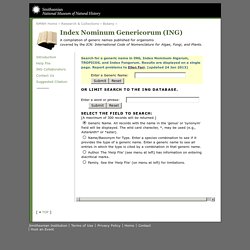
After the publication of the supplement to ING in 1986, we decided to add the number of the collaborator responsible for a major correction to the original entry as well. For an entry contributed by collaborator 8 and updated by collaborator 104, the collaborator would be listed as "(8/104). " 1. C. E. BPH (Botanico-Perodicum-Huntianum) from @HuntBotanical is your key to botanical publication abbreviations and information about that publication. Struggling to figure out what that citation abbreviation really stands for, or should really be, check here.
Resources for Plant Taxonomy Updates and Verification. #design twitter: a little thing thomas and i are hacking on… a free-form yet organized thinking tool for writers and notes; virtual card sorting, with saved states & multiple workspaces. approach your notes from any angle. Resources – Text Recycling Research Project. 2-minute how-to video: Text Analyzer. PCA/ACA. How to create and use a Europeana account.
Creating a Europeana account allows you to save your favourite items, and to create public and private galleries.
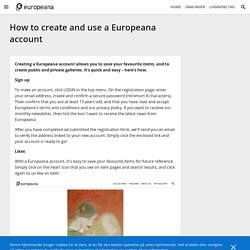
It's quick and easy – here's how. Sign up To make an account, click LOGIN in the top menu. On the registration page, enter your email address, create and confirm a secure password (minimum 8 characters). Then confirm that you are at least 13 years old, and that you have read and accept Europeana's terms and conditions and our privacy policy. After you have completed ad submitted the registration form, we'll send you an email to verify the address linked to your new account. Likes With a Europeana account, it's easy to save your favourite items for future reference. Galleries Creating and building galleries of your favourite items is easy too. In the My Likes & Galleries section of your account area, you can edit the names and descriptions of your galleries.
Exhibit. Researching British History Online – Resource list. Paleography. People. Possible. To Read. Write. Cambridge Digital Library ― University of Cambridge. Society for Cultural Anthropology. Handout Word2011. ArchiveGrid. Home - Introduction to the Biodiversity Heritage Library - LibGuides at University of Illinois at Urbana-Champaign. Recording overview - GarageBand Help. Resource Guide Photography & Editing. Photography is our universal language. Here is Your Open Access Art/Science Toolkit. Dear Maura, “What I do know is we’re here and it’s now.”
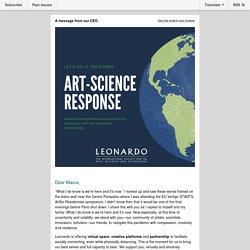
I looked up and saw these words framed on the bistro wall near the Centre Pompidou where I was attending the EU Vertigo STARTS ArtSci Residencies symposium. I didn’t know then that it would be one of the final evenings before Paris shut down. How to design an excellent scientific poster. ‘Science is not finished until it is communicated’, so said Sir Mark Walport, former medical scientist and the Chief Executive of the UK Research and Innovation (UKRI).

About - Royal Botanic Gardens, Kew research repository. (8) JSTOR isn't Google: How to use search to find articles and ebooks on JSTOR. Can help - Research tools on JSTOR - LibGuides at JSTOR. Searching: Boolean Operators – JSTOR Support. What's in this article: Boolean operators are used to connect your search terms, and can be used to either narrow or broaden your search results.
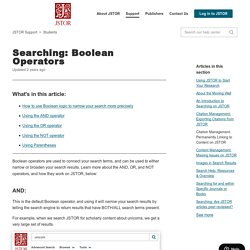
Learn more about the AND, OR, and NOT operators, and how they work on JSTOR, below: This is the default Boolean operator, and using it will narrow your search results by telling the search engine to return results that have BOTH/ALL search terms present. A Basic Guide to Rare Book Research. In my job as the manager of the Library at Museums Victoria (Australia), I am frequently required to conduct rare book research for programs, displays, online projects, or to establish the provenance of a book.
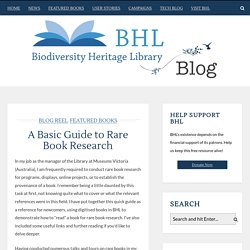
I remember being a little daunted by this task at first, not knowing quite what to cover or what the relevant references were in this field. I have put together this quick guide as a reference for newcomers, using digitised books in BHL to demonstrate how to “read” a book for rare book research. I’ve also included some useful links and further reading if you’d like to delve deeper. Multilingual Multiscripted Plant Name Database (M.M.P.N.D.) - A showcase for Distributed databases related to plant names. Join us for a Women in Natural History Wikipedia Editing Workshop on 13 March! The illustrations featured in this graphic were created by women who will be featured in our Wikipedia Editing Workshop.
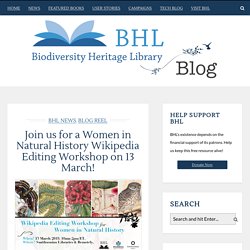
From left to right: Harriet Scott Morgan, Australian lepidoptera and their transformations, v. 1 (1864); Roberta McIntosh, A monograph of the British marine annelids, v.2, pt.2 (1910); Elizabeth Twining, Illustrations of the natural orders of plants with groups and descriptions, v. 2 (1868); Mary Emily Eaton, Field book of common gilled mushrooms (1928); Elizabeth Gould, The Birds of Europe, v. 1 (1837). Help us enhance information in Wikipedia about women in natural history during our Wikipedia Editing Workshop on 13 March in celebration of Women’s History Month! In collaboration with Smithsonian Libraries and with support from Wikimedia DC, we’ll be hosting a Wikipedia Editing Workshop from 10am-2pm ET on 13 March to improve and create Wikipedia articles related to women in natural history.
Search Results. Hunt Institute for Botanical Documentation. BPH Online Introduction BPH Online is a fully indexed and searchable database documenting (as comprehensively as possible) periodicals published between 1665 and the present that have addressed the plant sciences.
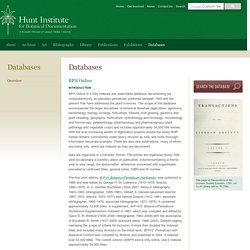
The scope of the database encompasses the larger disciplines of botanical literature (agriculture, agronomy, bacteriology, biology, ecology, floriculture, forestry, fruit growing, genetics and plant breeding, geography, horticulture, hydrobiology and limnology, microbiology and microscopy, palaeontology, pharmacology and pharmacognosy, plant pathology and vegetable crops) and includes approximately 34,000 title entries. With the ever-increasing wealth of digitization projects around the world, BHP Online remains consistently under heavy revision as new, and more thorough, information becomes available. HathiTrust Research Center Extends Non-Consumptive Research Tool... HathiTrust has reached a tremendous milestone in the history of HathiTrust and the HathiTrust Research Center’s services.
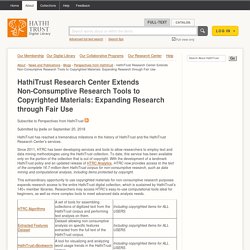
Since 2011, HTRC has been developing services and tools to allow researchers to employ text and data mining methodologies using the HathiTrust collection. Announcing the New “About BHL” Site! We’re excited to announce the launch of the new “About BHL” site! What is BHL’s history? Who’s involved in the Library? What tools and services does BHL offer? How do you search, download content or access data and developer tools in BHL? Announcing the New “About BHL” Site! Epsilon: Search Results. Requiring ORCID in Publication Workflows: Open Letter. Join the many publishers that have committed to requiring ORCID iDs in the publishing process for their journal(s)!
In November, 2015, a group of publishers asked ORCID to help facilitate communications about their plans to require authors to use an ORCID iD, including hosting this open letter explaining their rationale, developing best practices for using iDs in publishing, and maintaining the signatory list. The publishers’ goal is to encourage others to join them in supporting the adoption of ORCID.
Publishers signing this open letter are committing to requiring ORCID iDs following specific implementation standards. While all publishing organizations are welcome to sign the letter, an Effective Date is only shown in the table below for those who demonstrate that their use of ORCID meets our best practices. Read more in ORCID Open Letter - One Year On Report. Knowledge Base – Feedback & support for ORCID.
The Rules for Long S. Edelweiss+ Kepler.gl, an open source tool for mapping large-scale spatial data. Instant Maps with kepler.gl – ProfHacker - Blogs - The Chronicle of Higher Education. Digital Mappa. For examples of what is possible using DM, you can explore these projects below. While the projects below concern medieval materials, Digital Mappa is an environment that can bring together and host any kind of digital image/text collection, be it ancient texts, medieval maps, images of 3D artifacts, transcripts of 19th-century poems, or 20th-century music scores.
These DM 1.0 projects showcase how varied the structure and presentation of materials can be in DM, depending on the editorial designs of the creators. Digital Mappa 1.0. An app called Edit. How to design an award-winning conference poster. A good academic conference poster serves a dual purpose: it is both an effective networking tool and a means by which to articulately communicate your research. How to start a successful blog.
British Library: Manuscripts and Archives. How Can I Share It. Transcription Tools: a survey by Katie Mika, NDSR Resident. IsisCB Explore—What You Can Do Now, and What You Can Expect. Through Another’s Eyes: Troubleshooting with User Switching. Backup and Development with Installatron. Biodiversity Heritage Library - Download How To. American National Biography Online. Scirus - for scientific information. Book titles with full text online. IsisCB Explore. The 3 Ps of plant science publishing « Botany One. Medieval Digital Resources – Created by the Medieval Academy of America.